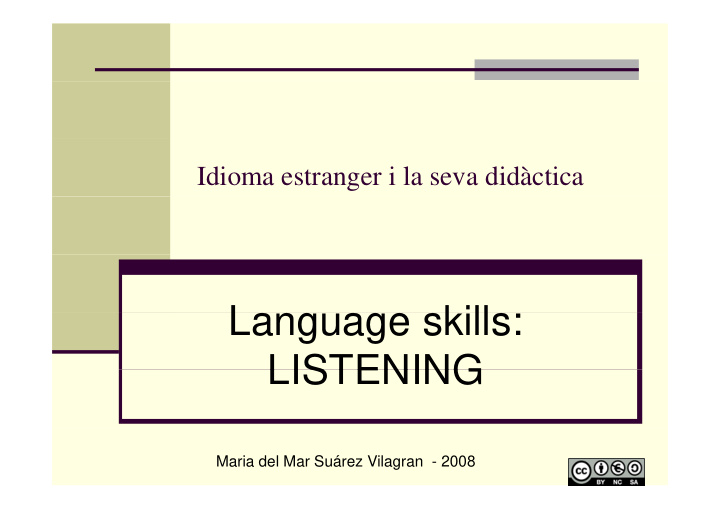



Idioma estranger i la seva didàctica L Language skills: kill LISTENING LISTENING Maria del Mar Suárez Vilagran - 2008
LANGUAGE SKILLS LANGUAGE SKILLS Language educators have long used the concepts of Language educators have long used the concepts of four basic language skills: � Listening g � Speaking � Reading � Writing W iti The four basic skills are related to each other by two The four basic skills are related to each other by two parameters: � the mode of communication: oral or written � the direction of communication: receiving or producing the message
CLASSIFICATION OF SKILLS CLASSIFICATION OF SKILLS SKILLS ORAL WRITTEN RECEPTIVE RECEPTIVE LISTENING LISTENING READING READING PRODUCTIVE SPEAKING WRITING
� Concern for the order of presentation of the C f th d f t ti f th skills within a teaching unit or cycle. � Which ones do you think would usually come Whi h d thi k ld ll first? � Receptive and then productive (listening and R ti d th d ti (li t i d speaking and then reading and writing) � Nowadays the concern lies on the implementation of tasks where the 4 skills are i l t ti f t k h th 4 kill integrated.
CLASSIFICATION OF SKILLS CLASSIFICATION OF SKILLS SKILLS ORAL WRITTEN RECEPTIVE RECEPTIVE LISTENING LISTENING READING READING PRODUCTIVE SPEAKING WRITING
Strategies to help understand input (R.P.) 1. Simplify your input � not too fast � clearly � � long pauses long pauses � controlled vocabulary � short sentences and not too complex � not too many pronouns (try to use nouns)
2. Extra help � Body language: face expression, gestures y g g p g � Specific references: posters, pictures, objects (realia) (realia) � Interesting subjects for the kids � One type of intonation for one type of � One type of intonation for one type of message
3. Encourage interaction through communicative strategies � � confirmation of what the child is saying fi ti f h t th hild i i � comprehension check � ask for clarifications k f l ifi ti � repetitions � expansion of what the SS said i f h h SS id 4. Promote a positive attitude � Be enthusiastic � Motivate
3 stages before learning a language 3 stages before learning a language � 1. Silent period: non-verbal answers but understands � 2. Early production stage: starts to produce following a given model (songs, rhymes) g g ( g y ) � 3. Speech emergence stage: spontaneous
LISTENING LISTENING 2 TYPES OF SITUATIONS: - INTERACTIVE - NON-INTERACTIVE NON-INTERACTIVE - Exercise: give 3 examples of each and think of the main difference between them.
LISTENING LISTENING INTERACTIVE NON-INTERACTIVE - face-to-face -listening to the radio, TV, conversations and ti d films, lectures, or sermons fil l t telephone calls - we are alternately we are alternately - ONLY listening ONLY li i listening and speaking - we usually don't have the - chance to ask for - chance to ask for opportunity to ask for t it t k f clarification, repetition, or clarification, slower speech slower speech from our p or repetition or repetition. conversation partner.. In such situations
2 TYPES OF LISTENING COMPREHENSION � Intensive: - fill in the gaps g p - True/false - Correct the statement Correct the statement - Follow instructions - TPR - matching
2 TYPES OF LISTENING COMPREHENSION � Extensive: - Main idea - Exercise: check typology in R.P. and say Exercise: check typology in R P and say whether they are interactive or non-interactive and intensive or extensive and intensive or extensive.
LISTENING: Discussion LISTENING: Discussion � Think back about your experience learning a language. What activities helped you most in developing the listening skill in and outside the classroom? � What can a teacher do to promote listening that an audio- or video-recorder cannot do? � Limitations of using recorders in class? � What can a recorder do that most English � What can a recorder do that most English teachers cannot?
What prerecorded cassettes can’t do What prerecorded cassettes can t do � Eye contact E t t � Body language � Monitoring of your comprehension/attention � Monitoring leading to repetition g g � Monitoring leading to rephrasing � Fillers, eg. um, er, well Fillers, eg. um, er, well � Interruption � Interaction � Interaction � Negotiation
LISTENING LISTENING Let’s play: Chinese whispers Reading pack: picture dictation (c’s boy) Yellow submarine song Natalia’s pack
Recommend
More recommend